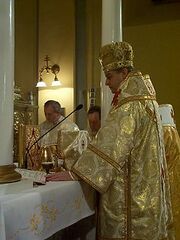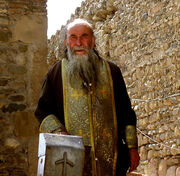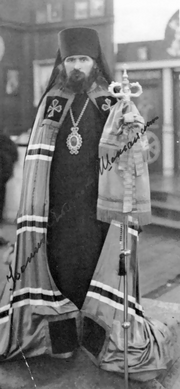Eastern Church vestments[]

Icon of St. Gregory the Illuminator wearing the omophorion, a type of phelonion worn by bishops called the polystavrion, epigonation, epitrachelion and sticharion (fourteenth century fresco, Mistras).

Eastern Catholic bishop wearing a sakkos, omophorion, and mitre (Prešov, Slovakia).

Georgian Orthodox priest wearing rasson, epitrachelion and epimanikia (Mtskheta, Republic of Georgia).

Archbishop John (Maximovich) wearing an episcopal mantle.
In the Orthodox Church, any member of the clergy, of whatever rank, will be vested when serving his particular function during the Divine Liturgy or other service. Eastern Catholics use identical vestments as their Orthodox counterparts. As in the Latin-rite Catholic Church, the use of vestments is rooted in the early history of the church. The various vestments serve several different functions. The three forms of stole (Orarion, Epitrachelion, and Omophorion) are marks of rank. The three outer garments (Sticharion, Phelonion, and Sakkos) serve to distinguish the clergy from the laity. Some are practical (Zone and Epimanikia), holding the other vestments in place. Some (Nabedrennik and Epigonation) are awards of distinction.
In addition to these functions, most vestments carry a symbolic meaning as well. These symbolic meanings are often indicated by the prayer that the priest says as he puts each item on. These prayers are verses taken directly from the Old Testament, usually the Psalms. For example, the prayer for the Sticharion is from Isaiah 61:10:
- My soul will rejoice in the Lord, for he has clothed me with a garment of salvation and wrapped me in a robe of gladness; he has placed a crown on my head as on a bridegroom, and adorned me with beauty as a bride. [1]
- Sticharion (Greek στιχάριον)
- Actually a form of the garment worn at baptism, this is the one vestment worn by all clergy. Though against Church canons, it is even used by non-ordained persons carrying out a liturgical function, such as an "altar boy". For priests and bishops, it is made of lightweight material, usually white. It corresponds most closely with the Western alb (see above).
- Orarion (Greek ὀράριον)
- A long narrow strip of cloth worn by deacons over the left shoulder and reaching to the ankle in both front and back. It is also worn by subdeacons and, in some places of the Greek tradition, by tonsured altar servers. It corresponds to the Western stole (see above).
- Epitrachelion (Greek ἐπιτραχήλιον, "over the neck")
- This stole is worn by priests and bishops as the symbol of their priesthood. It is worn around the neck with the two adjacent sides sewn or buttoned together, leaving enough space through which to place the head. It corresponds to the Western stole (see above).
- Epimanikia (Greek ἐπιμανίκια)
- Cuffs bound with laces. The deacon wears them beneath the sticharion, priests and bishops above. They are not used by any lower rank.
- Zone (Greek ζώνη)
- Cloth belt worn by priests and bishops over the epitrachelion. Corresponds to the Western cincture (see above).
- Phelonion (Greek φαιλόνιον or φελόνιον)
- Large conical sleeveless garment worn by priests over all other vestments, with the front largely cut away to free the hands. Byzantine rite Bishops may also wear the phelonion when not serving according to hierarchical rubrics. Corresponds to the Western chasuble (see above).
- Sakkos (Greek σάκκος)
- Instead of the phelonion, the bishop usually wears the sakkos or Imperial dalmatic. This is a tunic reaching below the knees with wide sleeves and a distinctive pattern of trim. It is always buttoned up the sides.
- Nabedrennik (Slavonic набедренникъ)
- A square or rectangular cloth suspended on the right side by two adjacent corners from a strap drawn over the left shoulder. This is a relatively recent Russian invention and is not used in the Greek tradition. It is an award, so it is not worn by all priests. Bishops do not use it.
- Epigonation/Palitsa (Greek ἐπιγονάτιον "over the knee"; Slavonic палица, "club")
- A stiff diamond-shaped cloth that hangs on the right side of the body; it is suspended by one corner from a strap drawn over the left shoulder. It is worn by all bishops and as an award for priests.
- Omophorion (Greek ὠμοφόριον)
- This is the distinctive episcopal vestment, a wide cloth band draped about the shoulders in a characteristic manner. It corresponds to the Western pallium (see above).
- Mitre (Greek Μίτρα)
- The Byzantine Orthodox mitre is modeled on the ancient Byzantine imperial crown; it is worn by all bishops and in some Slavic traditions also awarded to some high-ranking priests. The bishop's mitre is surmounted by a cross, but the priest's is not; both are bulbous and adorned with icons. Coptic Orthodox & Ethiopian Orthodox bishops also wear the Byzantine mitre. Armenian Orthodox, on the other hand, have the Byzantine mitre as part of the normal vestments worn by priests of all ranks, and their bishops are distinguished by wearing mitres after the western shape. Mitres are not worn in the Syriac Orthodox tradition, where a decorated hood like an amice called masnaphto , meaning 'turban', is worn instead by prelates. [2].
- Pectoral cross
- A large cross is worn around the neck by all bishops, but not necessarily by all priests. In Russian usage, the style of Pectoral cross worn indicates the rank of the priest.
- Engolpion/Panagia
- Engolpion (Greek ἐγκόλπιον) is a general term for something worn upon the bosom; here, it refers to a medallion with an icon in the center. A Panagia (Greek Παναγία, All-holy, one of the titles of the Theotokos) is an engolpion with Mary as the subject of the icon; this is worn by all bishops. All primates and some bishops below primatial rank have the dignity of a second engolpion, which usually depicts Christ.
- Mantle (Greek μανδύας)
- This is a sleeveless cape that fastens at the neck and the feet, worn by all monks. The usual monastic mantle is black; that worn by the bishop as he enters the church for a service but before he is vested is more elaborately colored and decorated. This is, strictly speaking, an item of street wear, not a vestment; however, in modern usage it is worn only in church.
- Varkas
- This is a broad stiff band of heavily embroidered brocade and decoration, functioning like a collar, worn exclusively by Armenian Orthodox priests over the phelonion. It corresponds to, and is likely derived from, the Western amice.
Despite their often elaborate design, the vestments are generally intended to focus attention on God, and the office of the person wearing them, rather than on the person himself. It is partly for this reason that a Russian phelonion is designed with a very high back, so that when the priest is standing facing the altar his head is almost completely hidden. Other items, such as the epimanikia or cuffs, represent manacles or chains, reminding the wearer and others that their office is a position of service.